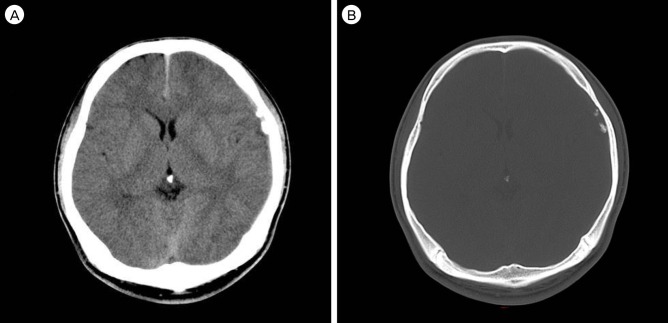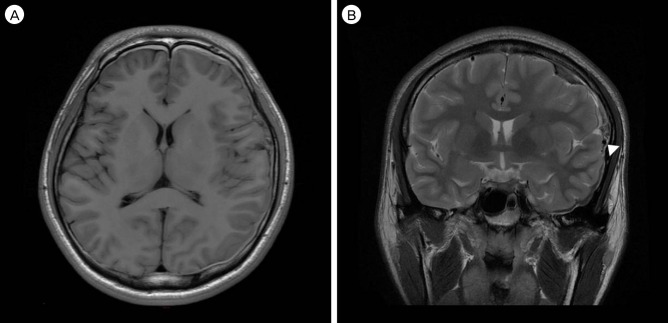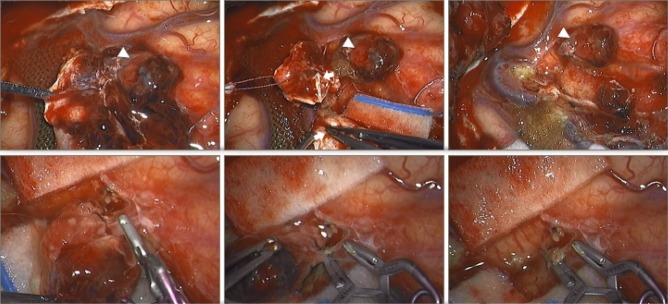J Cerebrovasc Endovasc Neurosurg.
2016 Sep;18(3):322-326. 10.7461/jcen.2016.18.3.322.
Traumatic Pseudoaneurysm Related to Calcified Nodules of Cerebral Convexity Dura Mater in an American College Football Player
- Affiliations
-
- 1Department of Neurosurgery Konkuk University College of Medicine, Seoul, Korea. youngil.chun@gmail.com
- KMID: 2355662
- DOI: http://doi.org/10.7461/jcen.2016.18.3.322
Abstract
- Repeated concussion is common among football players; however, these minor blunt head trauma rarely result in serious complications. We report a case of a young college football player who presented acute subdural hematoma, cerebral edema, and seizure due to pseudoaneurysm rupture. The pseudoaneurysm, located at the cortical branch of the middle cerebral artery, was speculated to be formed by dural calcification and adhesion with the underlying brain, possibly due to repeated concussions. Following successful excision of the pseudoaneurysm and control of brain swelling, the patient recovered without sequelae and was discharged after a short while.
MeSH Terms
Figure
Reference
-
1. Al-Motabagani M, Haroun H, Meguid EA. Calcification and ossification of the convexity of the falx cerebri and related subdural space in human cadavers. Neurosciences (Riyadh). 2004; 10. 9(4):261–264. PMID: 23377245.2. Allen GV, Gerami D, Esser MJ. Conditioning effects of repetitive mild neurotrauma on motor function in an animal model of focal brain injury. Neuroscience. 2000; 99(1):93–105. PMID: 10924955.
Article3. Bailes JE, Petraglia AL, Omalu BI, Nauman E, Talavage T. Role of subconcussion in repetitive mild traumatic brain injury. J Neurosurg. 2013; 11. 119(5):1235–1245. PMID: 23971952.
Article4. Baugh CM, Stamm JM, Riley DO, Gavett BE, Shenton ME, Lin A, et al. Chronic traumatic encephalopathy: neurodegeneration following repetitive concussive and subconcussive brain trauma. Brain imaging Behav. 2012; 6. 6(2):244–254. PMID: 22552850.
Article6. Cantu RC, Mueller FO. Brain injury-related fatalities in American football, 1945-1999. Neurosurgery. 2003; 4. 52(4):846–852. discussion 852-3. PMID: 12657180.
Article7. Centers for Disease Control and Prevention (CDC). Sports-related recurrent brain injuries--United States. MMWR Morb Mortal Wkly Rep. 1997; 3. 46(10):224–227. PMID: 9082176.8. Collins MW, Grindel SH, Lovell MR, Dede DE, Moser DJ, Phalin BR, et al. Relationship between concussion and neuropsychological performance in college football players. JAMA. 1999; 9. 282(10):964–970. PMID: 10485682.
Article9. Daghighi MH, Rezaei V, Zarrintan S, Pourfathi H. Intracranial physiological calcifications in adults on computed tomography in Tabriz, Iran. Folia Morphol (Warsz). 2007; 5. 66(2):115–119. PMID: 17594669.10. DeFord SM, Wilson MS, Rice AC, Clausen T, Rice LK, Barabnova A, et al. Repeated mild brain injuries result in cognitive impairment in B6C3F1 mice. J Neurotrauma. 2002; 4. 19(4):427–438. PMID: 11990349.
Article11. Dubey A, Sung WS, Chen YY, Amato D, Mujic A, Waites P, et al. Traumatic intracranial aneurysm: a brief review. J Clin Neurosci. 2008; 6. 15(6):609–612. PMID: 18395452.
Article12. Galldiks N, Dohmen C, Neveling M, Fink GR, Haupt WF. A giant bilateral calcified chronic subdural hematoma. Neurocrit Care. 2010; 4. 12(2):272–273. PMID: 19902386.
Article13. Guskiewicz KM, McCrea M, Marshall SW, Cantu RC, Randolph C, Barr W, et al. Cumulative effects associated with recurrent concussion in collegiate football players: the NCAA Concussion Study. JAMA. 2003; 11. 290(19):2549–2555. PMID: 14625331.14. Kumar M, Kitchen ND. Infective and traumatic aneurysms. Neurosurg Clin N Am. 1998; 7. 9(3):577–586. PMID: 9668189.
Article15. Larson PS, Reisner A, Morassutti DJ, Abdulhadi B, Harpring JE. Traumatic intracranial aneurysms. Neurosurg Focus. 2000; 1. 8(1):e4.
Article16. Lath R, Vaniprasad A, Kat E, Brophy BP. Traumatic aneurysm of the callosomarginal artery. J Clin Neurosci. 2002; 7. 9(4):466–468. PMID: 12217684.
Article17. Logan SM, Bell GW, Leonard JC. Acute subdural hematoma in a high school football player after 2 unreported episodes of head trauma: a case report. J Athl Train. 2001; 12. 36(4):433–436. PMID: 12937485.18. Raju BS, Purohit AK, Murthy SR, Sundaram C, Sanjay T. Traumatic distal anterior cerebral artery aneurysm in a child: a case report. Neurol India. 2001; 9. 49(3):295–298. PMID: 11593250.19. Thurman DJ, Branche CM, Sniezek JE. The epidemiology of sports-related traumatic brain injuries in the United States: recent developments. J Head Trauma Rehabil. 1998; 4. 13(2):1–8.20. Tubbs RS, Kelly DR, Lott R, Salter EG, Oakes WJ. Complete ossification of the human falx cerebri. Clin Anat. 2006; 3. 19(2):147–150. PMID: 16283636.
Article
- Full Text Links
- Actions
-
Cited
- CITED
-
- Close
- Share
- Similar articles
-
- Lyophilized Dura Mater Patch Graft in Glaucoma Valve Implantation
- Acute Infrapatellar Fat Pad Injury after Non-contact, Hyperflexion Injury in a Professional Football Player: A Case Report
- Post-traumatic calcified epidermoid cyst in the posterior fossa: a case report
- A Case of Acute Severe Transient Thrombocytopenia Immediately after Cranioplasty using an Artificial Dura Mater
- Electrocardiographic Abnormalities following Syncope during Warm-up in a Professional Football Player: A Case Report





